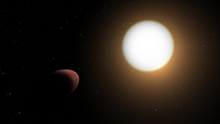

 16h37m15.5754s, +07° 11′ 00.1190″
16h37m15.5754s, +07° 11′ 00.1190″| Observation data Epoch J2000 Equinox J2000 | |
|---|---|
| Constellation | Hercules |
| Right ascension | 16h37m 15.5766s[1] |
| Declination | 07° 11′ 00.110″[1] |
| Apparent magnitude (V) | 12.1[2] |
| Characteristics | |
| Evolutionary stage | main-sequence star[3] |
| Spectral type | F8V[2] |
| Astrometry | |
| Radial velocity (Rv) | −40.69±1.00[1] km/s |
| Proper motion (μ) | RA: −9.756[1] mas/yr Dec.: 2.779[1] mas/yr |
| Parallax (π) | 1.8332 ± 0.1073 mas[1] |
| Distance | 1,800 ± 100 ly (550 ± 30 pc) |
| Details | |
| Mass | 1.220+0.039 −0.036[4] M☉ |
| Radius | 1.436+0.052 −0.031[4] R☉ |
| Luminosity | 3.3[1] L☉ |
| Surface gravity (log g) | 4.35±0.02[1] cgs |
| Temperature | 6110±160[5] K |
| Metallicity [Fe/H] | 0.06±0.13[4] dex |
| Rotational velocity (v sin i) | 10.60±0.90[4] km/s |
| Age | 4±1[4] Gyr |
| Other designations | |
| Database references | |
| SIMBAD | data |
WASP-103 is an F-type main-sequence star located 1,800 ± 100 light-years (550 ± 30 parsecs) away in the constellation Hercules. Its surface temperatureis6,110±160 kelvins (K). The star's concentration of heavy elements is similar to that of the Sun.[4] WASP-103 is slightly younger than the Sun at 4±1 billion years.[4] The chromospheric activity of the star is elevated due to interaction with the giant planet on a close-in orbit.[5]
A multiplicity survey in 2015 found a suspected stellar companion to WASP-103, at a projected separation of 0.242″±0.016″.[7]

In 2014 one super-Jupiter planet, named WASP-103b, was discovered by the transit method.[8] The planet is orbiting its host star in 22 hours and may be close to the limit of tidal disruption.[2] Orbital decay was not detected by 2020.[9] In early 2022, the planet was popularized because of its shape similar to a potato.[10]
The planetary atmosphere contains water, and possibly hydrogen cyanide, titanium(II) oxide, or sodium.[11] The planet has an elevated carbon to oxygen molar fraction of 0.9[3] or 1.35+0.14
−0.17, therefore it is nearly certain to be a carbon planet.[12]
The planetary equilibrium temperature is 2,484±67 K, although a big difference exists between the night side and day side. The dayside temperature is 2,930±40 K, while the night side temperature is 1,880±40 K.[3]
| Companion (in order from star) |
Mass | Semimajor axis (AU) |
Orbital period (days) |
Eccentricity | Inclination | Radius |
|---|---|---|---|---|---|---|
| b | 1.455+0.090 −0.091 MJ |
0.01987+0.00020 −0.00021 |
0.9255456±0.0000013 | <0.15 | 87.3±1.2° | 1.528+0.073 −0.047 RJ |
|
| |||||||||||||
|---|---|---|---|---|---|---|---|---|---|---|---|---|---|
| |||||||||||||
| Stars |
| ||||||||||||
| |||||||||||||
| |||||||||||||
| |||||||||||||
| Galaxies |
| ||||||||||||
| |||||||||||||
| |||||||||||||